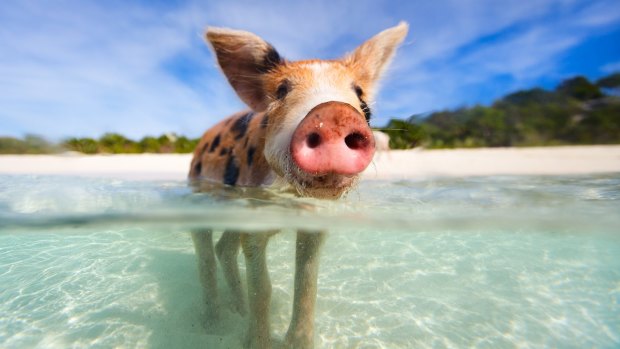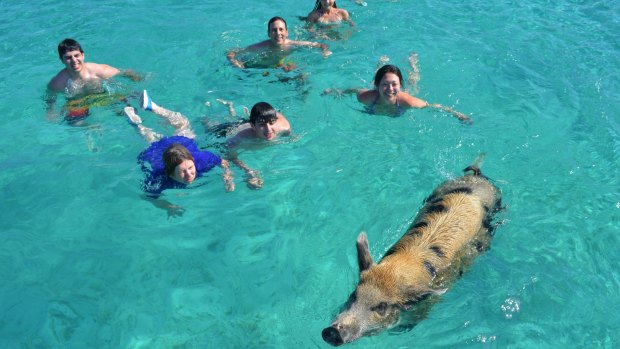This was published 4 years ago
Swimming pigs in the Bahamas: Attractions out of control, animal rights advocates say
By Ron Hurtibise

Swimming with pigs in the Bahamas has become a huge tourist attraction.Credit: SHUTTERSTOCK
Not long ago, the novelty of swimming with pigs off the shore of an uninhabited Bahama island elicited squeals of delight - and selfies aplenty.
Now, copycat attractions across the Bahamas are provoking concerns about mistreatment from animal rights advocates who are calling for regulation, inspection and limits on the number of swimming swine attractions.
If Kim Aranha, president of the Bahamas Humane Society, had her way, the government would outlaw the strange endeavour altogether.

It's estimated that more than 20 attractions have sprung up in recent years across the island chain - each offering tourists the opportunity to wade or boat in shallow waters as pigs beg them for scraps of food.Credit: SHUTTERSTOCK
"It's completely out of control," Aranha said in a telephone interview. "As an animal advocate, I hate it."
Aranha said the "swimming with pigs" phenomenon began years ago when some tourists boating through the Exuma chain noticed a group of pigs wandering around the beach of uninhabited Big Major Cay. As their boat approached, some of the pigs began swimming toward it.
"Pigs will do anything for food," Aranha said.
Where is all the pigs' waste going? In the water.
She estimated that more than 20 attractions have sprung up in recent years across the island chain - each offering tourists the opportunity to wade or boat in shallow waters as pigs beg them for scraps of food.
"People are travelling from Finland and Japan to see swimming pigs," she said. "Guys who operate boats on New Providence charge $US300 ($A426) to $US400 ($A568) to see swimming pigs and people will actually pay it so they can take pictures next to swimming pigs."
The attractions range in size from "Piggyville" on Abaco promoted by the Abaco Beach Resort and Boat Harbour Marina to, according to Aranha, "a guy that walks down Bay Street in Nassau with two pigs on a leash."
"They just go to the Ministry of Agriculture farm, buy a couple of piglets and they think they'll make millions."
Earlier this month, the Bahamas Tribune published portions of a social media post and photos from a Canadian travel blogger criticising treatment of pigs at a Freeport attraction called Celebrity Eco Adventures.
Writing on her Facebook page under the handle Kennidy From Canada, blogger Kennidy Fisher said she signed up for the excursion expecting the "beautiful and wonderful" Exuma experience she had heard about.
But at the Freeport attraction, she saw pigs corralled in a pen, exposed to wind and high seas on a narrow, unshaded cay, then tossed by employees into rough waves as the excursion boat she was in approached the shore.
"The men then went on a kayak across the water which they themselves could barely swim in, they let all the piggies out of the crate and THEN threw them in the water, IN HUGE WAVES, with current, they made these pigs swim in water and they were not allowed back on the beach every time they tried to get back onto shore, and they are fighting for their lives, and people are just trying to take photos with them, it was horrible."
Fisher said she chose not to participate further in the excursion, which cost $US30 per person. In an interview via Messenger, she said she was surprised at "how everyone there could see how unusual it was and still chose to participate."
A woman at Celebrity Eco Adventures who answered a phone call from the South Florida Sun Sentinel seeking comment about the controversy said she would relay the request to her public relations representative.
An April 18 Bahamas Tribune report quoted proprietor Barbara Danville as saying the attraction's pigs are "healthy, well kept and being properly housed and cared for."
The pen Fisher saw only houses the pigs for part of the morning so they don't run away when the first tour group shows up each day, she told the paper. She added that they are kept onshore overnight and fed plenty of water, grains and apples.
No one quite knows when the first encounter between tourists and swimming pigs took place on Big Major Kay in the Exumas. The earliest mention of swimming pigs as an Exuma tourist attraction in the archives of the website newspapers.com was in the London paper The Guardian in 2002.
Since then, the Exuma pigs have been the subject of numerous media accounts, including a book and movie, Pigs of Paradise, endorsed by the Bahamas' official tourism promotion agency. They were featured on the hit US reality show The Bachelor and in an infamous promotional video for the ill-fated Fyre Festival.
Also unknown is how the pigs got to Big Major Key. Aranha said it's likely an owner of one of the nearby Exuma islands owned some pigs and kept them there, knowing there was a natural source of freshwater, "until it was time to go to the butcher."
Yet wild pigs have apparently been swimming around the Bahamas for decades. In 1954, a story distributed to US newspapers reported that "wild pigs found on some Bahamas islands ... often go to sea, swimming from island to island in search of food or to escape the dogs of huntsmen."
Aranha and a colleague, Tip Burrows, executive director of the Humane Society of Grand Bahama, have been urging tourism and agriculture officials to regulate the copycat attractions.
They are concerned about the apparent lack of freshwater and shade in the holding pen at the Freeport attraction, and want the government to set down rules protecting pigs from sunburn and requiring they get proper shelter, clean fresh water, and appropriate food rather than scraps from tourists.
Following the deaths of seven pigs on Big Major Cay, veterinarians found large quantities of sand in the deceased animals' stomachs - possibly resulting from tourists throwing food on the beach, they said.
Aranha and Burrows said their pleas to the government have so far gone unanswered. Efforts by the Sun Sentinel to reach the nation's top agriculture and tourism officials were unsuccessful.
No comparable attraction exists in the United States.
If an entrepreneur did try to create one in the US, it would have to be licensed by the US Department of Agriculture's Animal and Plant Health Inspection Service and by its home state's department of health, according to USDA spokesman R. Andre Bell.
States' health departments might look askance at permitting humans to swim in water alongside pigs and their waste.
Referring to the Freeport attraction, Burrow asked, "Where is all the pigs' waste going? In the water. And it's near a very popular swimming beach, a snorkeling attraction and a kayak resort with cottages nearby."
In an email, US Centers for Disease Control spokeswoman Kate Fowlie said, "Pigs, like many animals, can sometimes carry germs that can make people sick. Any of these germs can be spread through pig feces, urine, and other body fluids."
Diseases that can be carried by even healthy looking pigs include leptospirosis, Salmonella, Campylobacter, cryptosporidiosis, and parasitic diseases like ringworm and ascariasis, Fowler's email said.
And don't be lulled just because they are cute, Aranha said.
"When they're hungry, they can get aggressive and bite."
TNS
See also: The 10 coolest animals to go swimming with
See also: Not just Fyre Festival: Travel scams are everywhere and here's how to spot them
Sign up for the Traveller Deals newsletter
Get exclusive travel deals delivered straight to your inbox. Sign up now.